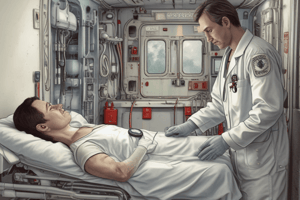Podcast
Questions and Answers
The mechanism of trauma involved in RTA includes:
The mechanism of trauma involved in RTA includes:
- Acceleration
- Deceleration
- Compression / Decompression
- Direct Collision Contact
- Shearing
- All of the above (correct)
The components of primary survey include all mentioned below except:
The components of primary survey include all mentioned below except:
- Airway patency with cervical control
- Disability
- Breathing
- Circulation with Hage Control (correct)
What is Sialectasis?
What is Sialectasis?
Dilatation of the ducts and alveoli
What are predisposing factors for Acute bacterial sialadenitis? (Select all that apply)
What are predisposing factors for Acute bacterial sialadenitis? (Select all that apply)
Viral parotitis is usually unilateral.
Viral parotitis is usually unilateral.
Salivary stones are more common in the __________ gland.
Salivary stones are more common in the __________ gland.
Flashcards are hidden until you start studying
Study Notes
Road Traffic Accident (RTA) Mechanisms
- Acceleration is a mechanism of trauma involved in RTAs
- Deceleration is a mechanism of trauma involved in RTAs
- Compression/Decompression is a mechanism of trauma involved in RTAs
- Direct Collision Contact is a mechanism of trauma involved in RTAs
- Shearing is a mechanism of trauma involved in RTAs
- All of the above mechanisms are involved in RTAs
Primary Survey Components
- Airway patency with cervical control is a component of primary survey
- Breathing is a component of primary survey
- Circulation with Hage Control is a component of primary survey
- Disability is a component of primary survey
Salivary Glands
- There are two main types of salivary glands: parotid gland and submandibular gland.
Sialectasis
- Dilatation of the ducts and alveoli
- Can cause stagnation and recurrent infection
- Differential diagnosis: Mumps (unilateral and recurrent)
- Treatment: Antibiotics, may resolve within 15 years of age, but may need surgery in adults
Infections/Inflammatory
- Acute: viral or bacterial
- Recurrent subacute or chronic
- Chronic infections: TB
- Granulomatous: Sarcoidosis
Viral Parotitis
- Bilateral
- Painful
- Associated with fever
- Typically occurs in children
- Swelling
- Self-limited
Acute Bacterial Sialadenitis
- Predisposing factors: poor oral hygiene, dehydration, duct obstruction
- Caused by Staph aureus
- Clinical features: pain, swelling, hotness, redness, fever, and fluctuations
- Treatment: MASHH (glandular massage, antibiotics, sialagogues, heat, and hydration) and drainage
Recurrent Subacute and Chronic
- Predisposing factors: sialectasis, stone, autoimmune diseases
- Differential diagnosis of lymph node: relation to meal, bimanual, rolling, and inspection of the duct
Salivary Stones
- More common in the submandibular gland
- Can be radio-opaque or radiolucent
- Clinical features: pain and swelling
- Treatment: removal of the stone
Salivary Gland Fistula
- External: caused by trauma or surgery
- Internal: caused by a stone
Degenerative Diseases
- Sialectasis
- Radiation sialadenitis
Autoimmune Diseases
- Salivary gland diseases
Salivary Neoplasms
- Various types of tumors that can occur in the salivary glands
Diagnostic Findings in Patients with a Salivary Mass or Enlargement
- Various diagnostic features and tests to identify salivary gland disorders
Studying That Suits You
Use AI to generate personalized quizzes and flashcards to suit your learning preferences.


